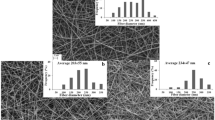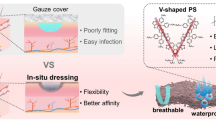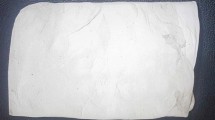Abstract
Novel multifunctional bio-based nanofibrous mats were prepared which contain the commonly used pain reducing local anesthetic benzocaine (BZC) and the in situ pH-detecting dye bromocresol green (BCG). These can serve as a dual nano-carrier system for wound healing applications, especially in the treatment of infected wounds. BZC and BCG were introduced into cellulose acetate (CA) based nanofibers using a single-step needleless electrospinning process. The resulting CA nanofibers show a homogenous fiber diameter distribution around 600 nm, hydrophobicity with a water contact angle of 134°, and simultaneous porosities on the nano-micro- scale. In spite of their hydrophobic character, the nanofibrous mats showed a huge water absorption capacity (1657%), as well as good stability at physiological pH (negligible degradation). All the mentioned properties remain unchanged upon the inclusion of either BZC or BCG. Results from the in vitro drug release studies showed a pH dependent (i.e. controllable) release of BZC, and confirmed the expected maximum drug release rate at pH 9.0, which would correspond clinically to the pH of an infected wound. The accompanying color change of the nanofibrous mats, provided through the encapsulated BCG (from yellow to blue), is noticeable within a few seconds after the pH changes from acidic to alkaline. This rapid response of NSAID, together with the visible absorption of included dye, show the capacity of the proposed nanofibrous mats as an in situ pH-detecting system. Finally, the biocompatibility of the proposed nanofibrous mats was proven using human skin fibroblast cells, confirming their potential to be used in wound treatment.
Graphical abstract











Similar content being viewed by others
References
Agarwal A, Raheja A, Natarajan T, Chandra T (2012) Development of universal pH sensing electrospun nanofibers. Sens Actuators B Chem 161(1):1097–1101
Bai X, Son SJ, Zhang SX, Liu W, Jordan EK, Frank JA, Venkatesan T, Lee SB (2008) Synthesis of superparamagnetic nanotubes as MRI contrast agents and for cell labeling. Nanomedicine 3(2):163–174
Bhowmick S, Rother S, Zimmermann H, Lee PS, Moeller S, Schnabelrauch M, Koul V, Jordan R, Hintze V, Scharnweber D (2017) Biomimetic electrospun scaffolds from main extracellular matrix components for skin tissue engineering application—the role of chondroitin sulfate and sulfated hyaluronan. Mater Sci Eng, C 79:15–22
Caldara M, Colleoni C, Guido E, Re V, Rosace G (2016) Optical monitoring of sweat pH by a textile fabric wearable sensor based on covalently bonded litmus-3-glycidoxypropyltrimethoxysilane coating. Sens Actuators B Chem 222:213–220
Candido RG, Gonçalves AR (2016) Synthesis of cellulose acetate and carboxymethylcellulose from sugarcane straw. Carbohyd Polym 152(Suppl C):679–686
Chen S, Liu B, Carlson MA, Gombart AF, Reilly DA, Xie J (2017) Recent advances in electrospun nanofibers for wound healing. Nanomedicine 12(11):1335–1352
Dagnon KL, Shanmuganathan K, Weder C, Rowan SJ (2012) Water-triggered modulus changes of cellulose nanofiber nanocomposites with hydrophobic polymer matrices. Macromolecules 45(11):4707–4715
Dargaville TR, Farrugia BL, Broadbent JA, Pace S, Upton Z, Voelcker NH (2013) Sensors and imaging for wound healing: a review. Biosens Bioelectron 41(Suppl C):30–42
Derikvand F, Yin DT, Barrett R, Brumer H (2016) Cellulose-based biosensors for esterase detection. Anal Chem 88(6):2989–2993
Deshwal GK, Panjagari NR (2018) Electrospun structures for dairy and food packaging applications. Res Rev J Dairy Sci Technol 6(1):17–23
Devarayan K, Kim B-S (2015) Reversible and universal pH sensing cellulose nanofibers for health monitor. Sens Actuators B Chem 209:281–286
Dias J, Baptista-Silva S, Sousa A, Oliveira A, Bártolo P, Granja P (2018) Biomechanical performance of hybrid electrospun structures for skin regeneration. Mater Sci Eng, C 93:816–827
Dobrila Z, Ljiljana S, Ljiljana Z (1990) Spectrophotometric determination of tilidine using bromocresol green and bromophenol blue. Acta Pharm Hung 60(5–6):179–181
Edwards JV, Fontenot KR, Liebner F, Condon BD (2018) Peptide-cellulose conjugates on cotton-based materials have protease sensor/sequestrant activity. Sensors 18(7):2334. https://doi.org/10.3390/s18072334
Finšgar M, Uzunalić AP, Stergar J, Gradišnik L, Maver U (2016) Novel chitosan/diclofenac coatings on medical grade stainless steel for hip replacement applications. Sci Rep 6:26653
Fuliaş A, Ledeţi I, Vlase G, Popoiu C, Hegheş A, Bilanin M, Vlase T, Gheorgheosu D, Craina M, Ardelean S (2013) Thermal behaviour of procaine and benzocaine Part II: compatibility study with some pharmaceutical excipients used in solid dosage forms. Chem Cent J 7(1):140
Gašparič P, Kurečič M, Kargl R, Maver U, Gradišnik L, Hribernik S, Kleinschek KS, Smole MS (2017) Nanofibrous polysaccharide hydroxyapatite composites with biocompatibility against human osteoblasts. Carbohyd Polym 177:388–396
Han SO, Youk JH, Min KD, Kang YO, Park WH (2008) Electrospinning of cellulose acetate nanofibers using a mixed solvent of acetic acid/water: effects of solvent composition on the fiber diameter. Mater Lett 62(4):759–762
Ismaiel S, Yassa D, Gad-El-Rub L (1975) Spectrophotometric determination of lidocaine in some pharmaceutical preparations using bromocresol green. Pharmazie 30(6):408
Jankowska DA, Bannwarth MB, Schulenburg C, Faccio G, Maniura-Weber K, Rossi RM, Scherer L, Richter M, Boesel LF (2017) Simultaneous detection of pH value and glucose concentrations for wound monitoring applications. Biosens Bioelectron 87:312–319
Kamal H, Abd-Elrahim FM, Lotfy S (2014) Characterization and some properties of cellulose acetate-co-polyethylene oxide blends prepared by the use of gamma irradiation. J Radiat Res Appl Sci 7(2):146–153
Kargl R, Mohan T, Bračič M, Kulterer M, Doliška A, Stana-Kleinschek K, Ribitsch V (2012) Adsorption of carboxymethyl cellulose on polymer surfaces: evidence of a specific interaction with cellulose. Langmuir 28(31):11440–11447
Kassal P, Zubak M, Scheipl G, Mohr GJ, Steinberg MD, Murković Steinberg I (2017) Smart bandage with wireless connectivity for optical monitoring of pH. Sens Actuators B Chem 246:455–460
Khoshnevisan K, Maleki H, Samadian H, Shahsavari S, Sarrafzadeh MH, Larijani B, Dorkoosh FA, Haghpanah V, Khorramizadeh MR (2018) Cellulose acetate electrospun nanofibers for drug delivery systems: applications and recent advances. Carbohydr Polym 198:131–141
Kiaee G, Mostafalu P, Samandari M, Sonkusale S (2017) A pH-mediated electronic wound dressing for controlled drug delivery. Tufts University, ProQuest Dissertations Publishing
Kruse CR, Singh M, Targosinski S, Sinha I, Sorensen JA, Eriksson E, Nuutila K (2017) The effect of pH on cell viability, cell migration, cell proliferation, wound closure, and wound reepithelialization: in vitro and in vivo study. Wound Repair Regen 25(2):260–269
Kurečič M, Sfiligoj Smole M (2013) Electrospinning: nanofibre production method. Tekstilec 56(1):4–12
Li X-Y, Zheng Z-B, Yu D-G, Liu X-K, Qu Y-L, Li H-L (2017) Electrosprayed sperical ethylcellulose nanoparticles for an improved sustained-release profile of anticancer drug. Cellulose 24(12):5551–5564
Li J-J, Yang Y-Y, Yu D-G, Du Q, Yang X-L (2018) Fast dissolving drug delivery membrane based on the ultra-thin shell of electrospun core-shell nanofibers. Eur J Pharm Sci 122:195–204
Lim Y-M, Gwon H-J, Jeun JP, Nho Y-C (2010) Preparation of cellulose-based nanofibers using electrospinning. In: Kumar A (ed) Nanofibers. InTech, Croatia
Marjanović B, Juranić I, Ćirić-Marjanović G, Pašti I, Trchová M, Holler P (2011) Chemical oxidative polymerization of benzocaine. React Funct Polym 71(7):704–712
Maver U, Bele M, Jamnik J, Gaberšček M, Planinšek O (2013) A fast and simple method for preparation of calcium carbonate–drug composites for fast drug release. Mater Res Bull 48(1):137–145
Maver T, Hribernik S, Mohan T, Smrke DM, Maver U, Stana-Kleinschek K (2015a) Functional wound dressing materials with highly tunable drug release properties. RSC Adv 5(95):77873–77884
Maver T, Maver U, Kleinschek KS, Raščan IM, Smrke DM (2015b) Advanced therapies of skin injuries. Wien Klin Wochenschr 127(5):187–198
Maver T, Maver U, Mostegel F, Griesser T, Spirk S, Smrke DM, Stana-Kleinschek K (2015c) Cellulose based thin films as a platform for drug release studies to mimick wound dressing materials. Cellulose 22(1):749–761
Maver T, Maver U, Stana Kleinschek K, Smrke DM, Kreft S (2015d) A review of herbal medicines in wound healing. Int J Dermatol 54(7):740–751
Maver T, Kurečič M, Smrke D, Kleinschek KS, Maver U (2016) Electrospun nanofibrous CMC/PEO as a part of an effective pain-relieving wound dressing. J Sol-Gel Sci Technol 79(3):475–486
Maver T, Gradišnik L, Kurečič M, Hribernik S, Smrke D, Maver U, Kleinschek KS (2017a) Layering of different materials to achieve optimal conditions for treatment of painful wounds. Int J Pharm 529(1–2):576–588
Maver T, Gradišnik L, Kurečič M, Hribernik S, Smrke DM, Maver U, Kleinschek KS (2017b) Layering of different materials to achieve optimal conditions for treatment of painful wounds. Int J Pharm 529(1–2):576–588
Maver T, Smrke DM, Kurečič M, Gradišnik L, Maver U, Kleinschek KS (2018a) Combining 3D printing and electrospinning for preparation of pain-relieving wound-dressing materials. J Sol-Gel Sci Technol 88(1):33–48
Maver U, Xhanari K, Zizek M, Korte D, Gradisnik L, Franko M, Finsgar M (2018b) A combination of interdisciplinary analytical tools for evaluation of multi-layered coatings on medical grade stainless steel for biomedical applications. Eur J Pharm Biopharm 128:230–246
Mehrabi F, Shamspur T, Mostafavi A, Saljooqi A, Fathirad F (2017) Synthesis of cellulose acetate nanofibers and its application in the release of some drugs. Nanomed Res J 2(3):199–207
Mohan T, Hribernik S, Kargl R, Stana-Kleinschek K (2015a) Nanocellulosic materials in tissue engineering applications. In: Poletto M, Ornaghi HL Jr (eds) Cellulose-fundamental aspects and current trends. InTech, Caxias do Sul
Mohan T, Kargl R, Tradt KE, Kulterer MR, Braćić M, Hribernik S, Stana-Kleinschek K, Ribitsch V (2015b) Antifouling coating of cellulose acetate thin films with polysaccharide multilayers. Carbohyd Polym 116:149–158
Mouriño V (2018) Nanoelectrospun matrices for localized drug delivery. In: Inamuddin, Asiri AM, Mohammad A (eds) Applications of nanocomposite materials in drug delivery. Elsevier, pp 491–508
Mouw JK, Ou G, Weaver VM (2014) Extracellular matrix assembly: a multiscale deconstruction. Nat Rev Mol Cell Biol 15(12):771–785
Nadrah P, Maver U, Jemec A, Tišler T, Bele M, Dražić G, Benčina M, Pintar A, Planinšek O, Gaberšček M (2013) Hindered disulfide bonds to regulate release rate of model drug from mesoporous silica. ACS Appl Mater Interfaces 5(9):3908–3915
Nagoba BS, Suryawanshi NM, Wadher B, Selkar S (2015) Acidic environment and wound healing: a review. Wounds Compend Clin Res Pract 27(1):5–11
Organization WH (2015) World report on ageing and health. World Health Organization, Geneva
Pal A, Goswami D, Cuellar HE, Castro B, Kuang S, Martinez RV (2018) Early detection and monitoring of chronic wounds using low-cost, omniphobic paper-based smart bandages. Biosens Bioelectron 117:696–705
Pallás I, Marcos MD, Martínez-Máñez R, Ros-Lis JV (2017) Development of a textile nanocomposite as naked eye indicator of the exposition to strong acids. Sensors 17(9):2134
Park JW, Hwang SR, Yoon I-S (2017) Advanced growth factor delivery systems in wound management and skin regeneration. Molecules 22(8):1259
Payn MM, Lawrence D, Willis R, Lamb EJ (2002) Sample matrix is critical in the evaluation of a dry-slide bromocresol green method for human albumin. Ann Clin Biochem 39(3):311–313
Percival SL, McCarty S, Hunt JA, Woods EJ (2014) The effects of pH on wound healing, biofilms, and antimicrobial efficacy. Wound Repair Regen 22(2):174–186
Perrin DD (1965) Dissociation constants of organic bases in aqueous solution. Butterworths, London
Phiriyawirut M, Phaechamud T (2012) Gallic acid-loaded cellulose acetate electrospun nanofibers: thermal properties, mechanical properties, and drug release behavior. Open J Polym Chem 2(01):21
Pilehvar-Soltanahmadi Y, Dadashpour M, Mohajeri A, Fattahi A, Sheervalilou R, Zarghami N (2018) An overview on application of natural substances incorporated with electrospun nanofibrous scaffolds to development of innovative wound dressings. Mini Rev Med Chem 18(5):414–427
Power G, Moore Z, O’Connor T (2017) Measurement of pH, exudate composition and temperature in wound healing: a systematic review. J Wound Care 26(7):381–397
Raggi M, Cavrini V, Di Pietra A (1985) A calorimetric assay for dicyclomine hydrochloride using bromocresol green. J Pharm Biomed Anal 3(3):287–291
Rahimi R, Ochoa M, Parupudi T, Zhao X, Yazdi IK, Dokmeci MR, Tamayol A, Khademhosseini A, Ziaie B (2016) A low-cost flexible pH sensor array for wound assessment. Sens Actuators B Chem 229:609–617
Rahimi R, Brener U, Chittiboyina S, Soleimani T, Detwiler DA, Lelièvre SA, Ziaie B (2018) Laser-enabled fabrication of flexible and transparent pH sensor with near-field communication for in situ monitoring of wound infection. Sens Actuators B Chem 267:198–207
Rodkey FL (1964) Binding of bromocresol green by human serum albumin. Arch Biochem Biophys 108(3):510–513
Roemhild K, Niemz F, Mohan T, Hribernik S, Kurecic M, Ganser C, Teichert C, Spirk S (2016) The cellulose source matters—hollow semi spheres or fibers by needleless electrospinning. Macromol Mater Eng 301(1):42–47
Rošic R, Pelipenko J, Kristl J, Kocbek P, Bešter-Rogač M, Baumgartner S (2013) Physical characteristics of poly (vinyl alcohol) solutions in relation to electrospun nanofiber formation. Eur Polymer J 49(2):290–298
Sabadini E, Carvalho LVC (2013) Visual demonstration of the ionic strength effect in the classroom: the Debye–Hückel limiting law. Quim Nova 36(1):187–189
Salvo P, Dini V, Kirchhain A, Janowska A, Oranges T, Chiricozzi A, Lomonaco T, Di Francesco F, Romanelli M (2017) Sensors and biosensors for c-reactive protein, temperature and ph, and their applications for monitoring wound healing: a review. Sensors 17(12):2952
Sayhan H, Beyaz SG, Çeliktaş A (2017) The local anesthetic and pain relief activity of alkaloids. In: Alkaloids-alternatives in synthesis, modification and application. InTech
Sheets AR, Hwang CK, Herman IM (2016) Developing “smart” point-of-care diagnostic tools for “next-generation” wound care, Chap. 17. In: Laurence J (ed) Translating regenerative medicine to the clinic. Academic Press, Boston, pp 251–264. https://doi.org/10.1016/B978-0-12-800548-4.00017-6
Stergar J, Ban I, Gradišnik L, Maver U (2018) Novel drug delivery system based on NiCu nanoparticles for targeting various cells. J Sol-Gel Sci Technol 88(1):57–65
Su W-H, Cheng M-H, Lee W-L, Tsou T-S, Chang W-H, Chen C-S, Wang P-H (2010) Nonsteroidal anti-inflammatory drugs for wounds: pain relief or excessive scar formation? Mediat Inflamm 2010:413238. https://doi.org/10.1155/2010/413238
Taajamaa L, Kontturi E, Laine J, Rojas OJ (2012) Bicomponent fibre mats with adhesive ultra-hydrophobicity tailored with cellulose derivatives. J Mater Chem 22(24):12072–12082
Tarus B, Fadel N, Al-Oufy A, El-Messiry M (2016) Effect of polymer concentration on the morphology and mechanical characteristics of electrospun cellulose acetate and poly (vinyl chloride) nanofiber mats. Alex Eng J 55(3):2975–2984
Tsekova PB, Spasova MG, Manolova NE, Markova ND, Rashkov IB (2017) Electrospun curcumin-loaded cellulose acetate/polyvinylpyrrolidone fibrous materials with complex architecture and antibacterial activity. Mater Sci Eng, C 73:206–214
Tungprapa S, Jangchud I, Supaphol P (2007a) Release characteristics of four model drugs from drug-loaded electrospun cellulose acetate fiber mats. Polymer 48(17):5030–5041
Tungprapa S, Puangparn T, Weerasombut M, Jangchud I, Fakum P, Semongkhol S, Meechaisue C, Supaphol P (2007b) Electrospun cellulose acetate fibers: effect of solvent system on morphology and fiber diameter. Cellulose 14(6):563–575
Üstündağ Okur N, Çağlar EŞ, Arpa MD, Karasulu HY (2017) Preparation and evaluation of novel microemulsion-based hydrogels for dermal delivery of benzocaine. Pharm Dev Technol 22(4):500–510
Van der Schueren L, Mollet T, Ceylan Ö, De Clerck K (2010) The development of polyamide 6.6 nanofibres with a pH-sensitive function by electrospinning. Eur Polym J 46(12):2229–2239
Van der Schueren L, De Meyer T, Steyaert I, Ceylan Ö, Hemelsoet K, Van Speybroeck V, De Clerck K (2013) Polycaprolactone and polycaprolactone/chitosan nanofibres functionalised with the pH-sensitive dye Nitrazine Yellow. Carbohyd Polym 91(1):284–293
Wang Q, Yu D-G, Zhang L-L, Liu X-K, Deng Y-C, Zhao M (2017) Electrospun hypromellose-based hydrophilic composites for rapid dissolution of poorly water-soluble drug. Carbohyd Polym 174:617–625
Wang K, Liu X-K, Chen X-H, Yu D-G, Yang Y-Y, Liu P (2018) Electrospun hydrophilic janus nanocomposites for the rapid onset of therapeutic action of helicid. ACS Appl Mater Interfaces 10(3):2859–2867
Weiser JR, Saltzman WM (2014) Controlled release for local delivery of drugs: barriers and models. J Controlled Release 190:664–673
Wongsasulak S, Patapeejumruswong M, Weiss J, Supaphol P, Yoovidhya T (2010) Electrospinning of food-grade nanofibers from cellulose acetate and egg albumen blends. J Food Eng 98(3):370–376
Yu D-G, Li J-J, Williams GR, Zhao M (2018) Electrospun amorphous solid dispersions of poorly water-soluble drugs: a review. J Control Release. https://doi.org/10.1016/j.jconrel.2018.08.016
Zahedi P, Rezaeian I, Ranaei-Siadat SO, Jafari SH, Supaphol P (2010) A review on wound dressings with an emphasis on electrospun nanofibrous polymeric bandages. Polym Adv Technol 21(2):77–95
Zavastin D, Cretescu I, Bezdadea M, Bourceanu M, Drăgan M, Lisa G, Mangalagiu I, Vasić V, Savić J (2010) Preparation, characterization and applicability of cellulose acetate–polyurethane blend membrane in separation techniques. Colloids Surf A 370(1):120–128
Acknowledgments
The authors would like to acknowledge the financial support for this research received from the Slovenian Research Agency (Grants Numbers: P2-0118, P3-0036, L2-5492, Z2-8168, I0-0029 and P1-0153).
Author information
Authors and Affiliations
Corresponding authors
Ethics declarations
Conflict of interest
The authors declare no conflict of interest.
Electronic supplementary material
Below is the link to the electronic supplementary material.
Rights and permissions
About this article
Cite this article
Kurečič, M., Maver, T., Virant, N. et al. A multifunctional electrospun and dual nano-carrier biobased system for simultaneous detection of pH in the wound bed and controlled release of benzocaine. Cellulose 25, 7277–7297 (2018). https://doi.org/10.1007/s10570-018-2057-z
Received:
Accepted:
Published:
Issue Date:
DOI: https://doi.org/10.1007/s10570-018-2057-z




